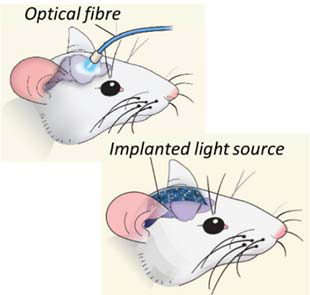Bio-integrated light sources
We focus on the integration of organic light-emitting devices (OLEDs) as versatile light sources into biomedical implants, with the application to optogenetics being of particular relevance. Optogenetics is an emerging method for non-invasive control of neuronal activity with light. It allows for specific activation and silencing of neurons by genetic addition of light-sensitive ion-channels into the neuronal membrane. In combination with optical read-out of neuronal activity through genetically encoded Calcium or voltage sensitive fluorescent markers, it can provide all-optical write/read capability. However, most currently available light sources for optogenetics provide only poor spatial control (fibres) or are highly invasive (microscope).
With a variety of OLEDs designed for specific applications, we overcome obstacles in miniaturization, flexibility, durability, and driving conditions. OLEDs have so far mostly been used for consumer electronics (smartphone displays, TVs) and lighting. In contrast to the widely used inorganic LEDs, OLEDs can be deposited on a very wide range of substrate materials in all kind of geometric arrangements, which is a major advantage for optogenetics and other biophotonics applications. A particular focus of our work in this area is to deposit OLEDs on microscopic silicon chips that contain the driver electronics to operate more than a thousand individual OLED pixels, each having dimensions similar to the size of a neuron. To achieve this, we have dramatically improved the brightness, the angular emission profile, and stability of OLEDs which is required to achieve reliable optical activation of neurons [Advanced Optical Materials, 2020; Advanced Optical Materials, 2022; Nature Photonics, 2023; Advanced Materials, 2023]. We have used this technology to study Drosophila melanogaster [Scientific Reports, 2016, Nature Communications, 2020a] and primary neuronal cultures [Advanced Biosystems, 2019]. In recent studies, we achieve an OLED density with single neuron resolution on shank-shaped bioimplants and activate firing of individual cells in living mice [Nature Electronics, 2023].
A related effort looks at using OLED light for fluorescence imaging through combination of OLEDs with distributed Bragg reflectors. Here we have been able to show live imaging of neuronal activity in the CNS of Drosophila [Advanced Materials, 2019].
For future use of OLEDs as implanted light sources, we are also developing ultra-thin substrateless OLEDs with a robust thin film barrier encapsulation. These may ultimately enable lamination of OLEDs onto brain tissue for high resolution local photo-stimulation of specific regions of the brain [Nature Communications, 2020b].
Apart from the design and optimization of light generating devices, a further challenge is the powering of implants and the detection of evoked neuronal signals. Ongoing research in our group looks at the development of wireless devices as well as on sensors for detection of fluorescence.


